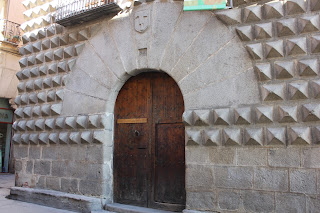The mountains that cross central Spain are beautiful. I saw them mainly from the window of the train. These and the mountains between Salamanca and Segovia were my inspiration for some of the scenes of the countryside in my story, though fictionalized.
I find the exposed stone and the alternations between the barren and forested areas remarkable.
We had a different view when we went to Segovia, with higher mountains and snow in one direction, and a vast plain on the other. Segovia is located where two rivers come out of the highlands to make a naturally defensible spot.
The following photos link into a panorama of the plain.
Here they are stitched together.
Friday, October 23, 2015
Wednesday, October 14, 2015
The House of Spikes
One of the remarkable houses of Segovia is called the Casa de los Picos, or House of Spikes. The front of the house is covered with remarkable granite points. It seems the house was older, with a standard facade and courtyard, and the granite facade was added later.
The house gained this appearance between about 1465 and 1500, which is the time frame I am using for the inspiration for the story of Diego.
The arched doorway is typical of the region for that time period, and is the same in Salamanca, though this is particularly grand example.
There are various stories about why the house was given this appearance, from a desire to change its name to a means to express a "medieval rudeness and surliness." The house was located right by the original entry gate to the city (demolished in the 19th century). I expect the house was built as a grand and unforgettable display for everyone who entered the city, with perhaps some measure of warning about the danger or prickliness of the residents of the house.
One of the remarkable houses of Segovia is called the Casa de los Picos, or House of Spikes. The front of the house is covered with remarkable granite points. It seems the house was older, with a standard facade and courtyard, and the granite facade was added later.
The arched doorway is typical of the region for that time period, and is the same in Salamanca, though this is particularly grand example.
The windows have a tiny balcony in front, allowing a bit of access to the outside when the shutters are open, but not really enough to fully stand on.
Both the main door and the windows have a symbol over them, representing the family that added this remarkable facade, the la Hoz family. The literal translation is sickle or reaping hook; to me, this looks like a billhook, which is a pruning device for fruit trees.
Subscribe to:
Comments (Atom)















